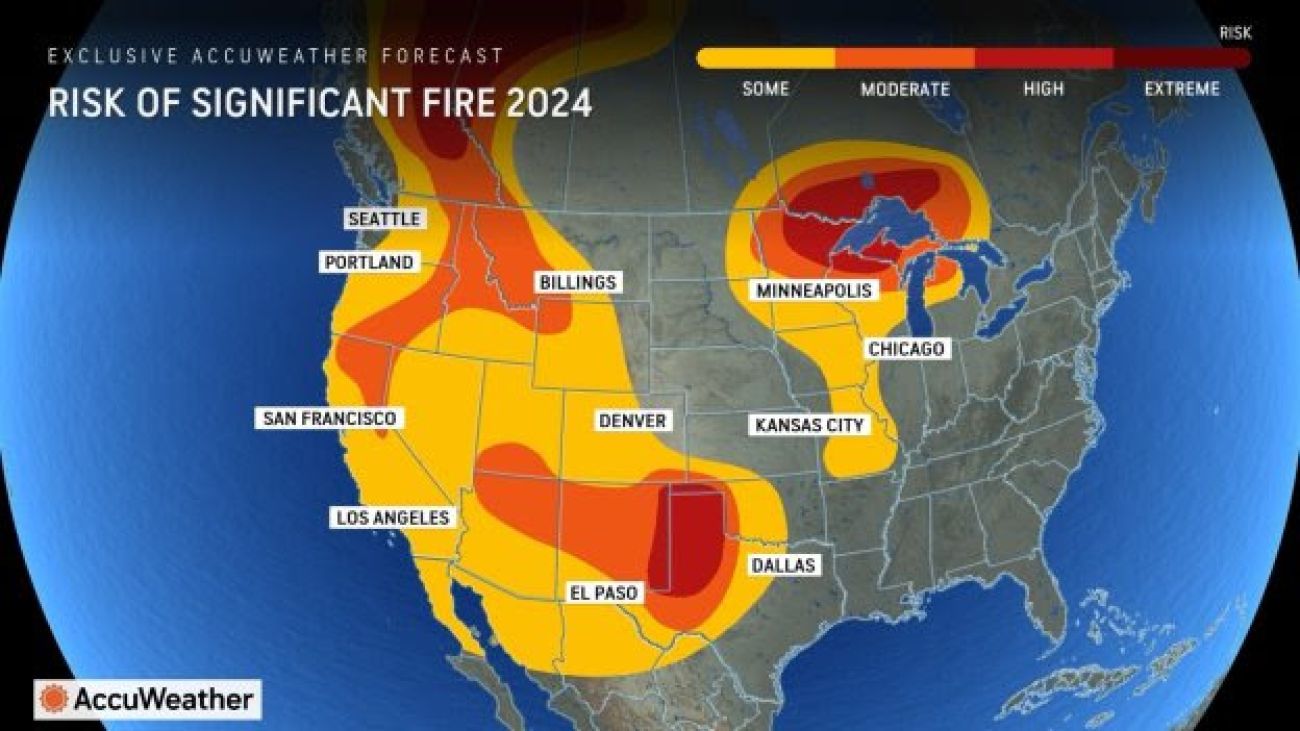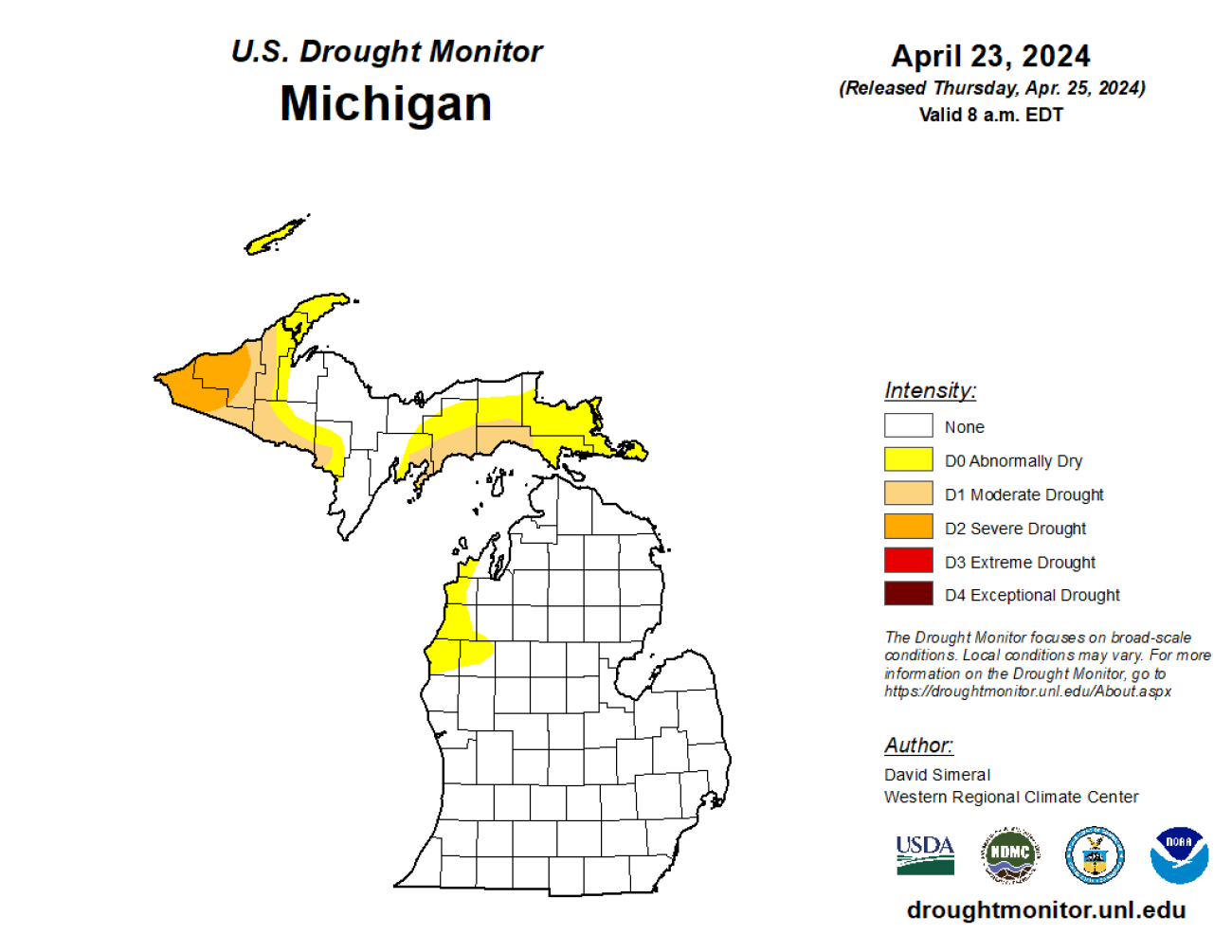After record-warm winter, Michigan may be in for a sweltering summer

- After a record-warm winter, federal scientists predict continued above-average warmth through the summer
- That means elevated wildfire risk and potentially more algae blooms and heat-related illnesses
- Long-term predictions are less accurate than short-term forecasts, and things could change
After a record-breaking warm winter and a balmy start to spring, experts say Michigan and surrounding states should brace for a scorching summer.
While that may make for an enjoyable boating season, it brings more risk of drought, wildfire and heat-related illnesses for humans and animals alike.
April temperatures throughout the state averaged 3 degrees to 5 degrees warmer than normal, said Matt Gillen, a meteorologist with the National Weather Service in Gaylord. And much of the state is in for an early May heatwave, with temperatures as high as 15 degrees above average toward the end of the week.
Related:
- Swim season is coming to Michigan. Swimmer's itch may be going away
- Michigan fishers are warned about harmful algae ahead of trout season
- DTE natural gas project in northern Michigan begins amid climate concerns
Longer-term, federal forecasters predict above-average temperatures through the summer and into the fall.
It’s not clear whether spring and summer rainfall will be above or below average. But Michigan still hasn’t recovered from an abnormally dry winter, which left much of the state with dangerously low soil moisture going into spring.
In the northern Lower Peninsula and Upper Peninsula, Gillen said, “those sandy soils don’t take long to dry out.” As a result, he said, “fire danger is a concern again.”
Nearly a quarter of the Great Lakes region was in drought as of late March, but recent rains have helped alleviate that problem. Still, soil moisture remains below average in much of Michigan, with 21 percent of the state’s landmass abnormally dry.
The worst conditions exist in the heavily forested Upper Peninsula, where most of Gogebic and Ontonagon counties are in severe drought.
AccuWeather, a global weather forecasting company, is predicting elevated fire risks throughout the Upper Midwest this summer, said Brandon Buckingham, a meteorologist for the company in Grand Rapids.

Michigan is not alone. Nearly all the continental U.S. is expected to be warmer than average this summer — again. As human fossil-fuel consumption continues to warm the earth’s climate, historical averages have become an increasingly unreliable predictor of future temperatures.
Michigan’s average temperatures have warmed more than 1.5 degrees Fahrenheit since 1960, and could rise another 6.5 degrees more by mid-century if society fails to lower greenhouse gas emissions.
Gillen said the El Niño climatological cycle that contributed to warmer winter conditions across the northern U.S. is waning, and a La Niña cycle is on the way. But that cycle, characterized by cooler and wetter conditions across much of the U.S., will not begin developing until at least June.
Fire risks, warmer waters
The combination of warmth and dryness raises concerns about potential wildfires, particularly in the next few weeks while trees still haven’t “greened up” for the season, said Paul Rogers, a fire-prevention specialist with the Michigan Department of Natural Resources.
Those bare trees and brush act as tinder, igniting easily when wind causes embers to escape from backyard burn piles. Fear of early-season wildfires has already prompted the DNR to issue one “red flag” warning this spring.
Already, Rogers said, his department has responded to about 200 fires this spring. The vast majority of them were caused by intentionally lit fires that grew out of control.
Rogers urged people burning leaves or other debris to keep water and a rake nearby at all times.
“The biggest thing we hear when we get to a fire to assist is, ‘I just never thought it would move that fast,’” Rogers said.
The DNR prohibits open burning of debris when fire danger is high. Before lighting an open fire, residents of the U.P. and northern Lower Peninsula can call 866-922-2876 or check this map to find out whether burning is allowed that day.

Warm air temperatures combined with a lack of late-season snowmelt have also raised temperatures in some Michigan’s lakes and rivers, prompting early returns of migratory fish and sparking concerns about summer algae blooms.
AccuWeather’s Buckingham, an avid fisherman, said he enjoyed an extended walleye season because the fish ran upriver from the Great Lakes “so much earlier than usual.”
“Luckily, some timely rains have limited the rivers from continuing that steady rise in temperatures,” Buckingham said, “But they're still running above average overall.”
In the Muskegon River near Croton, for instance, temperatures have stayed above average since January, at times rising as much as 10 degrees above normal. As of 2 p.m. Tuesday, the daily temperature had exceeded the all-time high for April 30.
The Au Sable River at Mio was also warmer than average. Same goes for the Manistee River near Wellston, the Clinton River at Sterling Heights, the River Raisin near Monroe, the Saginaw River at Saginaw and the Miners River near Munising.
And surface water temperatures in four out of the five Great Lakes are warmer than they were at this time in any of the past five years.
If the warming trend holds, it also raises the odds of heat-related illnesses. Heat waves are the leading cause of weather-related death in the U.S., and Michigan is not immune. More than 1,800 people visited emergency departments for heat-related illnesses in 2018, according to the Michigan Department of Health and Human Services.
Michigan Environment Watch
Michigan Environment Watch examines how public policy, industry, and other factors interact with the state’s trove of natural resources.
- See full coverage
- Subscribe
- Share tips and questions with Bridge environment reporter Kelly House
Michigan Environment Watch is made possible by generous financial support from:
Our generous Environment Watch underwriters encourage Bridge Michigan readers to also support civic journalism by becoming Bridge members. Please consider joining today.
See what new members are saying about why they donated to Bridge Michigan:
- “In order for this information to be accurate and unbiased it must be underwritten by its readers, not by special interests.” - Larry S.
- “Not many other media sources report on the topics Bridge does.” - Susan B.
- “Your journalism is outstanding and rare these days.” - Mark S.
If you want to ensure the future of nonpartisan, nonprofit Michigan journalism, please become a member today. You, too, will be asked why you donated and maybe we'll feature your quote next time!






